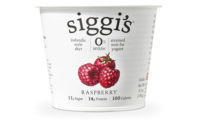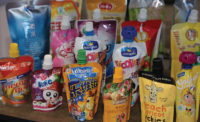
Scott Bossong, marketing director of dairy packaging, Sealed Air’s Cryovac Food Packaging, Duncan, S.C.
PJ Corcoran, director of DPET sheet, Octal, Muscat, Oman
Erin Reynolds, senior marketing manager, dairy, Evergreen Packaging, Memphis
Michelle Schmitt, container marketing supervisor, Berry Plastics, Evansville, Ind.
Dairy Foods: Dairy processors are developing specific foods to appeal to children. These might be eaten at home or at school. Discuss the key points a processor must know about packages intended to be opened by young children and consumed away from home.
Erin Reynolds: As the primary supplier of school milk cartons, Evergreen Packaging understands the importance of packaging tailored to meet children’s needs. Children desire packaging [that] is easy to open and provides a good drinking [experience]. [Our] Twist-It spout carton delivers well on those expectations. The Twist-It carton is also re-sealable, helping to prevent spills and is usable with or without a straw. In test markets, 90% of children preferred the Twist-It carton to their present package, and overall consumption increased 15%.
Scott Bossong: Packaging designed for children has to be safe and extremely user-friendly. For example, rigid packaging designed for children should always feature rounded edges to prevent cuts that could result from sharp straight edges. Also, making a package easy to open and reclose for children can prove challenging, as they may not be at the development stage to fully close a zipper or secure a lid tightly onto a tub.
Additionally, processors should avoid using oxygen scavenging sachets in a package meant for children to avoid the risk of accidental ingestion. If a product is highly oxygen-sensitive, processors can consider incorporating oxygen scavenging film into their packaging solution.
Dairy Foods: Product packaging for club stores often calls for unitizing two or more cans or other rigid containers. Discuss some of the ramifications for a dairy foods processor.
PJ Corcoran: The criteria for unitizing containers from the club stores imposes both limitations and opportunities on the package design and raw material choice for these containers for dairy food processors. There are three key elements to keep in mind. First, the secondary packaging may need to be handled separately in production; [this] could add cost and complications for production. The secondary packaging typically must be robust in order to keep the pack intact, hence another increase in cost.
In addition, all dairy food processors need to be extremely careful that all the products in the pack have the same expiration dates, so the products can remain in the store for sale. If not, loss of revenue could be incurred.
Dairy Foods: What color trends do you see in dairy foods packaging? Do the colors depend upon the product (that is, milk, cheese, yogurt, ice cream, etc.)?
Reynolds: Children live in a world of multi-colored, bold, entertaining packaging. [We advocate] the use of full-color graphics and interesting content on milk cartons as a way to effectively engage children and encourage them to become lifelong milk consumers.
Michelle Schmitt: Dairy artwork seems to follow the ingredients for the health-conscious consumer: pure and simple.
Dairy Foods: Describe any special effects you are creating on packages through the use of coatings, foils, holographic films, etc.
Schmitt: [Our] indirect flexographic printing offers photographic quality that cannot be achieved with offset print. Details of light-colored food, water droplets and blended colors come to life with this CMYK process print applied directly to the container. This technology is more cost effective than pressure-sensitive labels or shrink sleeves. Opaque printing on clear containers prevents contents from affecting artwork.
Bossong: [Our] printing capabilities allow for specialized flood printing that can give films the look of a metalized bag or parchment paper. These printing options can give cheeses a high-end or premium look, while providing the protection and performance of a barrier bag or rollstock.
Dairy Foods: Share some examples of the best packaging of dairy foods from your company in the last year. Describe the processor’s requirements and how your company fulfilled them.
Reynolds: Processors are looking for consumer-preferred packaging. [Evergreen Packaging’s] Fresh-Look cartons deliver on that expectation. The Fresh-Look carton is a new paperboard package with a window that allows customers to preview the product inside when shopping, as well as gauge how much is left so they know when it’s time to buy more.
In market research, consumers gave paper cartons with windows an overall “A” or “outstanding” rating. Consumers believe a carton with windows will be superior to current packaging options at providing key benefits such as making the product inside more appealing, allowing them to easily see how much is left inside and use of renewable resources.
Dairy Foods: Describe how your company collaborates with the processor and the package designer on rigid packaging. Have you participated in a crowdsourcing program involving package design?
Schmitt: Our design center is fully staffed with industrial designers solely dedicated to package and consumer product creativity. We can work side by side with our customer via on-site ideation meetings. Designers communicate their imagination and concepts through hand sketching and 3D computer modeling based off the customer’s project brief/idea. Customers witness the package concepts coming to life [and critique] the concepts, providing us with immediate feedback to give them what they desire. This radically reduces design lead-time.
We can turn around prototype models within hours on our in-house prototype system. The result: very creative, feasible and cost-effective concepts.
Corcoran: Even though crowdsourcing seems like a great tool for collaboration, at this point crowdsourcing has not been used by the Octal staff to assist with rigid packaging design/manufacturing.
In the past several years, Octal’s staff has been asked to collaborate with processors/designers with many rigid packaging weight- and cost-reduction initiatives without losing a high aesthetic appeal. The first step we typically take is to pass along our frequently updated product specification sheets. Next, through open discussion and close collaboration, we strive to understand the exact requirements of the particular package they are redesigning. The collaborative dialogue helps our company provide them with a PET sheet product, which is tailor-made for their pertinent needs and demands, all at a cost-effective price. Lastly, we ensure that the correct processing of the sheet accomplishes their goals for weight and cost reduction.
Dairy Foods: What are the mega-trends affecting the packaging of dairy foods? What is happening now in Europe, Asia or Oceania that might show up in the United States?
Bossong: We’re seeing global trends towards convenience and sustainability. Consumers are busier than ever and require products that simplify steps of consumption. Packaging can play to this trend with reclosable and easy-open formats. Our semi-rigid Multi-Seal package allows the consumer to have these benefits while also reducing packaging materials compared to many rigid reclosable formats. Globally, consumers are beginning to value packages that will leave less of a carbon footprint and provide long-term sustainability.
Schmitt: IML labeling [in-mold labeling] continues to grow in the United States. Many customers are asking for custom-looking stock packages. The Quad Series offers a film-sealable, 409-diameter tub with a non-round base. This package fits in existing filling lines and offers 180-degree decoration as well as a base label. Berry Plastics will also offer a new stock Greek yogurt package [in the fourth quarter]. This package will have a 95-millimeter diameter and will hold 5.3 ounces of Greek yogurt. It can be decorated with shrink sleeves or printed.
Corcoran: We see two mega-trends. The first includes a major push to reduce carbon footprint and for companies to have a sustainable solution for their dairy foods packaging. As a result, there is a clear move away from polystyrene and towards PET as a primary packaging material in the dairy sector. The move is driven by recyclability, environmentally friendliness, flavor tainting, barrier performance and the price of PET material, compared to alternative options.
The second trend is many traditional single-serve thermoformed items are moving to a form/fill/seal packaging solution. The move is driven by hygiene, speed, shelf life and cost considerations. In addition, these innovations in barrier films, sealing technologies, product automation and handling are helping to move the consumers to products with extended shelf life, hence improving their experience with the food and its packaging.

Responses were provided by e-mail and edited. Share your thoughts about the direction of rigid packaging or add your comments to this article at www.dairyfoods.com.
European Supplier Showed Yogurt Cup at Pack Expo
At Pack Expo in September, Paccor demonstrated a new application of its most popular packaging, DuoSmart. It was used with a PLA cup developed for Danone’s Activia yogurt. The packaging is made up of a plastic cup and a detachable cardboard sleeve. DuoSmart is said to contain less plastic with a “zipper” option; the inner cup and sleeve are easily separated to different waste streams.
Paccor also showed its technologies for high-barrier packaging. Intended to block humidity and oxygen, the multilayer material helps extend the preservation of products by up to 24 months, the company states. Its offerings include cups combining plastic and paper, containers, lids, trays and coextruded sheets for food and non-food applications.
For more information, visit www.paccor.com
A New Package for a New Beverage
Dole Packaged Foods needed a container for its new make-at-home yogurt smoothie beverage. Dole’s Fruit Smoothie Shakers are made with frozen fruit and yogurt. A big complaint consumers have about making smoothies at home is the need for a blender, says Paul Panza, director of marketing, based in Westlake Village, Calif.
Dole’s found the solution in the packaging: consumers unscrew the cap, add about 7 ounces of juice to the fill line, re-apply the cap and shake for about 30-45 seconds.
The bottle is made of high-density polyethylene and has a full-body PVC shrink sleeve. Panza says the package had to be designed in a way to easily break up the fruit and yogurt pieces inside the container when consumers add the juice. A flat surface at the top and bottom was needed, as well as sides that would not restrict movement of the product inside.
Dole worked with blow-mold equipment maker Rocheleau Tools & Die Co., Fitchburg, Mass., to create various designs. Dole’s marketing and production teams balanced manufacturing concerns with consumer acceptability issues. Prototype designs were tested with consumers in focus groups to find the best shape that was easy for consumers to grasp and hold on to during shaking. Dole blow-molds the bottles at its Stockton, Calif., processing plant.
The smoothies are available in three flavors: strawberry, strawberry banana and mixed berry. The beverages, with a suggested retail price of $2.19, contain low-fat yogurt with live and active cultures and prebiotics and probiotics. They will be available nationally by the first quarter of 2012. –Jim Carper, editor in chief
For more information about Rocheleau, visit www.rocheleautool.com.


